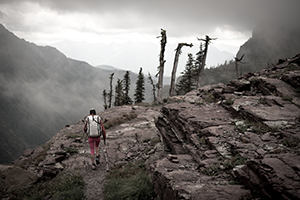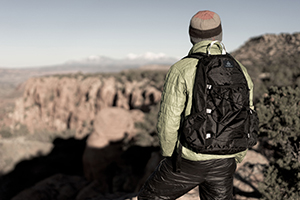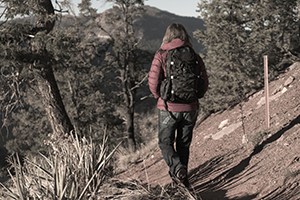 Camino Tips: what is ‘Lightweight’?
Camino Tips: what is ‘Lightweight’?
Mike St.Pierre, CEO and co-founder of Hyperlite Mountain Gear, gives us his insights into outdoor gear you need for your next long distance trail and handy Camino tips for your journey.
The first few days Cheryl Strayed hiked the Pacific Crest Trail she struggled to lift her pack off the ground. Most people reading this likely remember that feeling from early backpacking trips. Each step crushed your knees and your spirits as obscene weight drilled your leather boot-clad feet into the dirt. Those were the days you went “heavy,” when you brought your wool or fleece sweaters, four extra T-shirts, books and a six-pound, external-frame backpack. Long-distance walks such as the Camino de Santiago trails are increasingly appealing because you don’t have to carry a tent or much of the standard backpacking gear. On the other hand, people new to hikes can travel lighter, more comfortably and with fewer injuries if they consider a few simple concepts.
Understand Want You Need
Understanding what you need is the secret to knowing what you don’t. You absolutely need something to sleep on, to sleep in and to sleep under. Plus, you need water and food. You can take care of most of these things at the hotels, albergues and countless cafes along the Camino routes. However, you still need to carry insulating layers, waterproof layers, a knife, a headlamp water and snacks. I’m not saying you should leave your nonessential, favorite items behind, such as your journal, camera, etc. However, once you determine the gear you want to bring, ask yourself about each item and if you can either leave it behind or get a lighter version.

1) Can you leave behind those three books that you really want to read and take just one instead or download the kindle app for your phone?
2) Can you bright a light plastic water bottle instead of your Nalgene?
3) Can you replace your leather hiking boots with a good pair of trail running shoes that are significantly lighter and more comfortable and dry faster?
4) Can you bring a small knife, instead of your Leatherman?
5) Can you find a more compact headlamp instead of your stainless steel flashlight?
6) Can you leave behind your six pairs of underwear and socks? After all you can wash a pair of each every night, right?
7) Can you get a lighter backpack? Jacket? Clothes? Walking stick or trekking poles?
The answer to all of these questions is, most assuredly, yes.
Freeze not!
Bring the right clothes, the lightest clothes appropriate for the anticipated temperature range and some rainproof layers. Two fleece jackets will not keep you warm, especially if you wear both at the same time. A puffy jacket will provide significantly more warmth as air gaps between the down create an insulating layer that keeps the air next to your skin from cooling down. Also be sure to bring a warm, windproof hat, gloves and a couple pairs of warm, synthetic or light wool socks, plus high-quality synthetic or light wool base layers. Synthetic materials and lightweight wool products from Smartwool or other high-tech companies dry faster and stay warmer when wet. Depending on the season you are hiking, you may or may not need a full waterproof outfit. If you’re hiking in the summer, a breathable rain jacket will do. If temps are going to be colder and wetter, consider bringing rain pants and a rain jacket.
Keep your puffy jacket and any extra layers in a highly water-resistant, Cuben Fiber Stuff Sack 
And don’t forget about conduction and convection. Convection is when wind blows heat away from the surface of your skin; conduction is when you’re sitting on a cold rock, and your heat ebbs away. Prevent convection by hanging out in shelters or naturally protected areas when you’re not moving. Protect yourself in cold weather by wearing a down coat and/or by putting on your rain gear. A breathable rain jacket may be thin, but it works windproof wonders by trapping heat in.
Graze all day on lightweight, calorie-rich snacks
Bring enough food, and make sure it contains enough calories to keep you going. I’ve noticed that many people underestimate the actual calories they are consuming each day, especially over multiple days; and this is problematic because you’ll start to slowly slip into bonking (and become that stereotypical emaciated hiker). You burn between 2,000 and 4,500 calories per day, depending on how hard you are hiking and the time of year. However, if you’re not climbing mountains on your thru hike, you probably need about 2,500 – 3,000 calories. For three-season conditions, this equates to about 1.25 – 1.5 lbs. of food (2 lbs. per day in the winter is a safe bet). Keep these tips in mind:

2) Salty versus sweet. The longer you’re out there, the more likely you’ll crave salty foods more often. I’ll put uncooked Stove Top stuffing in flour tortillas with a few other things for a salty, crunchy snack.
3) Stay away from empty calories. I love chocolate as much as the next person, but I don’t rely on refined sugars. I get my sweet calories from dried fruits. Soak some dried fruit in your water to make a fruit drink. Ramen noodles are also empty calories unless you bulk them up with other ingredients. Try powered butter, milk and cheeses.
4) Eat fatty foods. I eat nuts all day. And I put full-fat milk in my coffee in the morning even a little butter in winter. Don’t worry about the extra fat; it’s the carbs that make you gain weight anyway.
5) Eat protein-rich foods at dinnertime. Your body has to work all night digesting hard proteins; so it’ll keep your furnace firing and provide you with nutrients to hit it hard the next day.
6) Graze all day. Once I’m packed and ready to go, I don’t stop all day. I walk at an easy pace, and I graze all day. It’s hard to eat when you’re working all day, but not if you just chew a handful of food.
Be Prepared
To me it’s about necessities; it’s about understanding what is truly important. You’re not going to leave anything you really need at home; you’re going to choose the right things that you really do need. I always plan for the potential worst conditions I might experience, but I plan practically and thoroughly. My trips have been successful because I put a lot of work into the master plan, I create contingency plans, I watch the weather forecast for periods of time, and I read up on the terrain, climate, etc., where I’m going. Remember the old Boy Scout adage, “Be Prepared.”
We would like to thank Mike, CEO and Co-founder of Hyperlite Mountain Gear, for his time and for providing these great Camino tips. If you have any questions or would like some more information please feel free to visit the Hyperlite Mountain Gear blog.
For more Camino tips or to book your trip, contact our travel specialists.

 Camino Tips: what is ‘Lightweight’?
Camino Tips: what is ‘Lightweight’?